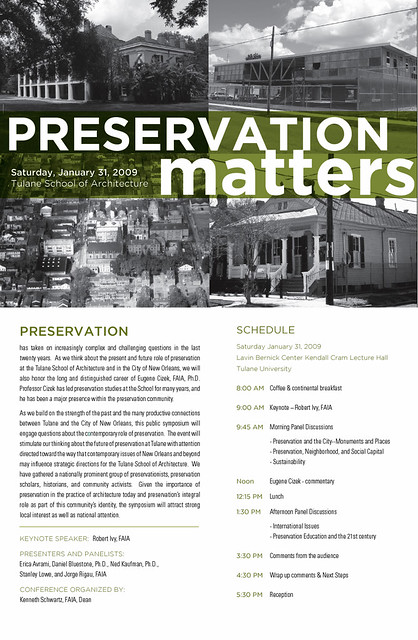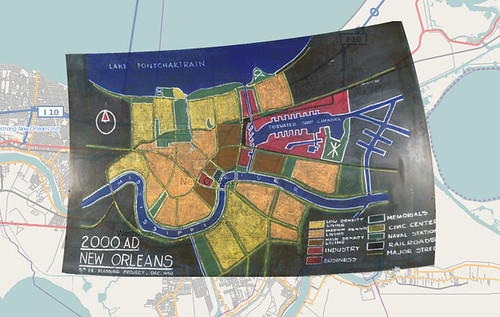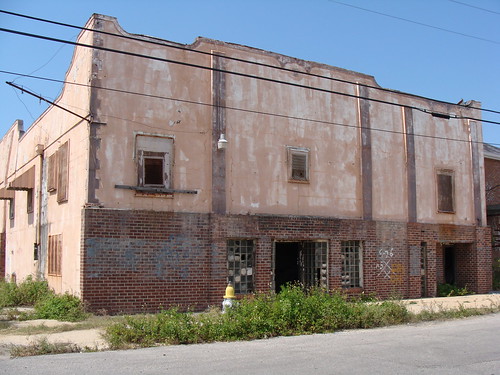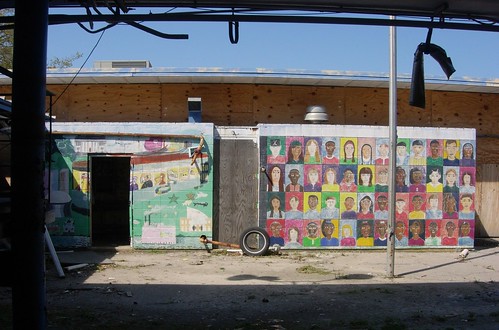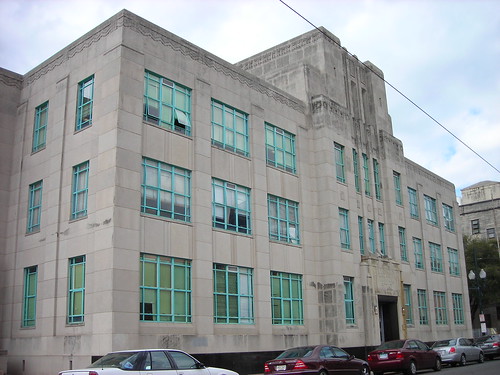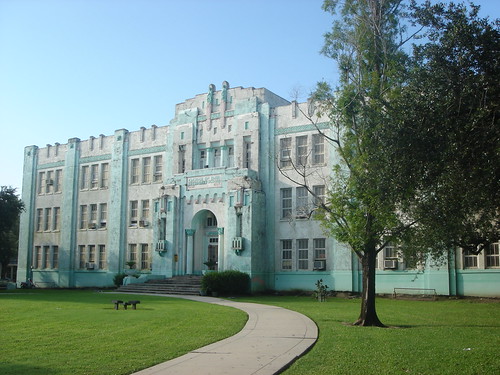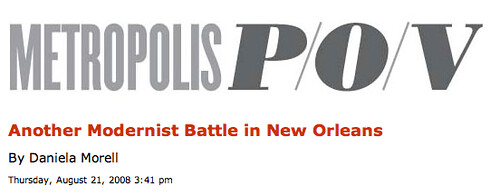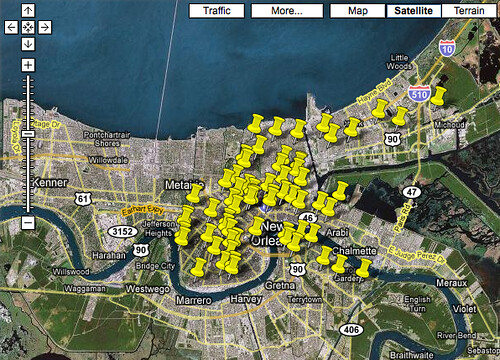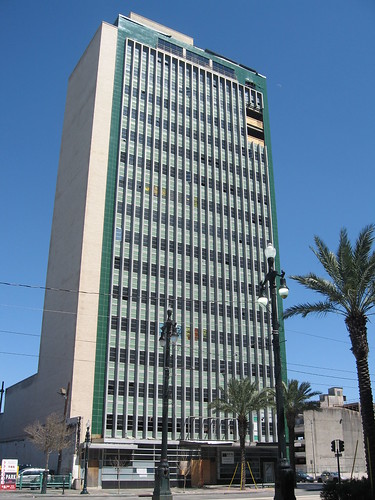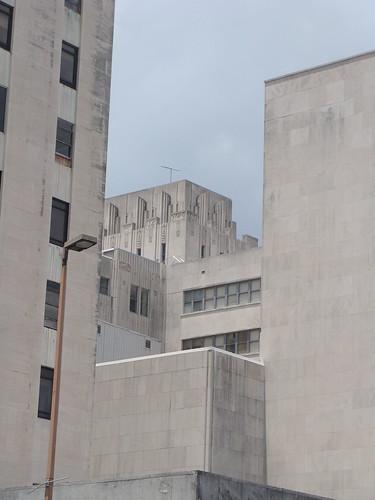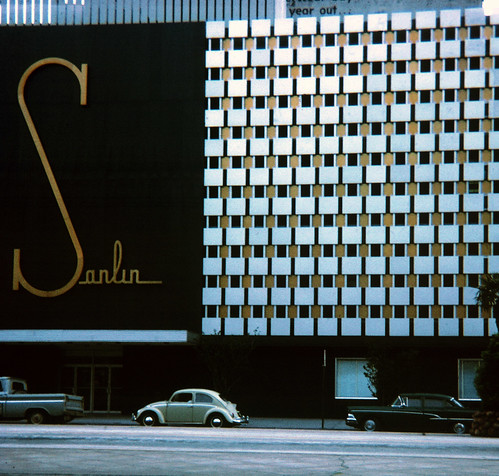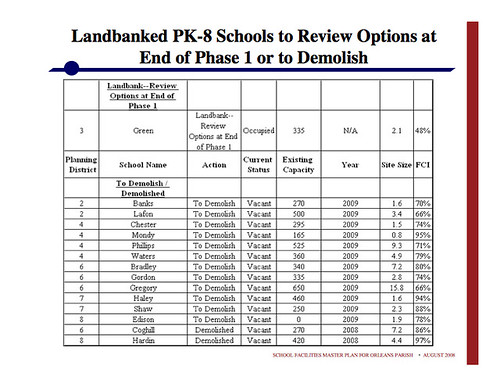
Today is the last day to submit a public comment to FEMA on the schools effected by the master plan. http://www.crt.state.la.us/
Of the thirty schools built in the 1950s, only Mahalia Jackson Elementary is slated for renovation. All other modernist schools are slated for demolition.
The OPSB and BESE approval of the School Facilities Master Plan for Orleans Parish (SFMPOP) may effectively erase mid-century modern school facilities from the cultural and architectural fabric of New Orleans. In the spring of 2008, DOCOMOMO Louisiana successfully nominated four of these schools to the Louisiana Landmarks Society Most Endangered List.
Phillis Wheatley Elementary School, 1955
2300 Dumaine Street, New Orleans, Louisiana
Charles R. Colbert, architect
Progressive Architecture citation
Thomy Lafon Elementary School, 1954
2601 Seventh Street, New Orleans, Louisiana
Curtis and Davis, architects
AIA Honor Award
George Washington Carver Junior - Senior High School, 1958
3059 Higgins Boulevard, New Orleans, Louisiana
Curtis and Davis, architects
Progressive Architecture First Design Award
McDonogh No. 39 / Avery Alexander Elementary School, 1952
5800 St. Roch Avenue, New Orleans, Louisiana
Goldstein, Parham and Labouisse; Freret and Wolf; Curtis and Davis, architects
First modern public school in New Orleans
In A Guide to the Architecture of New Orleans 1699-1959, Samuel Wilson, Jr. cites twenty-five of the thirty public schools which were built in the 1950s. Of these, ten have been demolished or are slated for demolition. Of the remaining fifteen mid-century modern schools, fourteen were assessed as "complete replacement." While many of these buildings were clearly damaged by Hurricane Katrina and the subsequent inundation, some are merely victims of neglect. The Recovery School District is indeed in the process of recovering. However, that is not an excuse for the wholesale demolition of mid-century modern public school architecture from the city of New Orleans. These schools were designed with respect to the city's environment and the structures are ripe for sustainable rehabilitation and reuse.
All of the schools suffered from deferred maintenance and general neglect under the governance of the Orleans Parish School Board. The primary structures at the Phillis Wheatley and Thomy Lafon Elementary Schools are elevated, but ground floor adjunct spaces were inundated. McDonogh No. 39 /Avery Alexander and George Washington Carver Schools were heavily inundated. The school facilities were cleared of materials and have been boarded up. These buildings have all been vacant since the storm.
In 1952, Charles R. Colbert was named the architect in charge of the new Office of Planning and Construction. He initiated a study of physical plant and invited local firms to submit designs for review in architectural competitions for the new schools. Architecture firms involved in this mid-century modern renaissance include: August Perez and Associates; Burk, LeBreton and Lamantia; Charles R. Colbert; Curtis and Davis; Favrot, Reed, Mathes and Bergman; Freret and Wolf; Goldstein, Parham and Labouisse; and Ricciuti Associates. Several mid-century school facilities were recognized by national architecture journals and organizations for their design merit. The Thomy Lafon School (1954, Curtis & Davis) received the AIA Honor Award. Progressive Architecture recognized the Phillis Wheatley School (1955, Charles R. Colbert). In 1957 Curtis & Davis earned Progressive Architecture's highest honor, the First Design Award, in for the innovative George Washington Carver Junior and Senior High Schools. New Orleans mid-century modern architects were not just making headlines and history. They were creating models of a regional modernism, inventive designs which are of a place, by a place and for a place.
While McDonogh no. 39 / Avery Alexander Elementary School in Gentilly did not receive any awards, it was nonetheless recognized as a model facility and was the first modern school built in New Orleans. McDonogh No. 39 is a "finger school," with four lengths of classrooms connected at one end to a broad wing of administrative offices. The bands of classrooms are connected by an exterior corridor on one side. Both sides of the classrooms and the hall have operable aluminum and glass windows, so they benefit from ample natural light and ventilation. In addition, the hall also filters the sunlight from the classroom, reducing heat gain. Grassy courtyards fill the space between the stretches of classrooms. While the school flooded post-Katrina, the design of the structure is historically significant and appropriate to our climate. The architects of record were Goldstein, Parham and Labouisse, in association with Freret & Wolf, and Curtis & Davis.
The Phillis Wheatley Elementary School is by far one of the most compelling monuments of the era. It is the culmination of a series of design innovations produced by Charles R. Colbert, one of the primary instigators of change in the public school facilities. Colbert describes how the formal structure of the Phillis Wheatley School was informed by the desire to create additional play space for the children on a relatively compact urban site.
"The city building code was interpreted to allow Wheatley to be a one-floor structure. Because of this decision, the design could combine the advantages of an exposed steel structure, without fireproofing, while concentrating its reduced weight on pile supports. The entire classroom structure was raised above grade to allow the enlargement of a diminutive play area and to create a play yard. Conventional post-and-beam construction would have created a field of hazardous columns throughout the play area while the use of the full effective depth of the cantilevered steel trusses eliminated most of these obstructions. The entire classroom structure was housed within twelve shop fabricated trusses and the twenty-two classrooms were located within this simple floor-to-ceiling structural envelope. Secondary steel joists spanned from truss to truss and supported the horizontal roof membrane, while floors consisted of six inch deep double tongue and groove wood decking that spanned between trusses. The truss, better recognized in bridges, thus became more than the support for a roof system. This old and widely used structural assembly allowed efficient shop fabrication, simple assembly, and a reduced job site construction period. The raison d'etre, to free the play yard, developed into something more.
The result was stunning. Airy, light-filled classrooms, elevated from the street, gave the effect of a modern tree-house, an appropriate and poetic setting for a child's classroom. The elevation of the Phillis Wheatley School protected the classrooms from the post-Katrina inundation of the city. Sadly the building is a victim of decades of neglect. The facility does require some intervention. The steel trusses could certainly benefit from a coat of paint. Also, the clear glass was replaced long ago with cheaper opaque plexi-glass panels. Improvements in glass and automated HVAC make it possible to renovate Wheatley to perform better than originally.
Both Phillis Wheatley and Thomy Lafon Elementary Schools were built on raised piers that saved them from the floodwaters after Hurricane Katrina. The open space underneath the elevated structure helps cool the building in our climate. This structural conceit is borrowed from the French Colonial tradition. Breezes naturally cool an elevated structure. In the case of Wheatley and Lafon, the elevated structures also created a wealth of covered play space, protected from the elements. Both schools were built with a sensitivity to local environmental conditions. The exterior walls were glass in Wheatley, mostly glass in Lafon. This gave the children new perspectives, as well as an abundance of natural light and ventilation. It is tragic that so many of the later generation of school buildings were designed as nearly windowless detention cells.
Colbert encouraged his fellow architects to consider the "emotional and spiritual needs of children" in their design of school buildings.
The George Washington Carver Junior-Senior High School was praised as a model school for the nation. Integrating a junior and senior high school on the same campus as an elementary school allowed the schools to share some common facilities.
The striking design of the auditorium with its concrete vault and hinged bridge-like buttresses helped establish Curtis and Davis as architects on the international stage. Progressive Architecture's recognition of this school with its highest design award in 1958 is a tribute to the architectural quality of Carver High School as well as the design reforms set in place by Charles Colbert.
Buildings dating from the modernist era are currently entering a period of extreme vulnerability. Their architectural and mechanical systems are reaching the end of their life cycle and are in need of re-investment. The clean and clear modernist vision is likewise marred by neglect and unsympathetic alterations during the past decades. While 19th century buildings sometimes become more romantic as they decay, the results of deferred maintenance on mid-century modern buildings are unflattering at best. In addition, the modernist style has yet to reach an era of broad understanding and appreciation by the general public. In New Orleans, the economic argument for demolition and new construction inevitably prevails. We need to preserve the most significant buildings of the twentieth century for our city's future.
Continued education and advocacy for these structures will raise awareness of their significance, quality and importance to the architectural and social history of New Orleans. Increased acceptance of modern buildings as legitimate structures to be maintained, rehabilitated, preserved and restored will help eliminate the threat of demolition. Conservation and re-use of existing buildings is also a widely acknowledged strategy for the increased overall sustainability of a city's building stock.
Modern and contemporary architecture has been seen by some as having had a negative impact. In particular, historic cities that lost significant urban fabric through urban renewal have been averse to the buildings that came in its place. While there has been opposition to their retention, attitudes have been changing. There is a growing appreciation for their role in the urban fabric as a record of diverse values and cultural movements.
New Orleans' current population is approximately half of its 1960 population, so there is less need for so many facilities. It appears that the plan is to clear the lots while FEMA funds are available for demolition and rebuild as necessary. However, in that process, struggling neighborhoods are deprived of a potential community center, artists' studio complex or musicians' practice space. These buildings are ripe for adaptive re-use and they belong to the people of New Orleans. Their structures are solidly engineered, designed in sympathy with our climate, and have become part of our cultural and historic fabric.
The renovation of a modernist school that was built in a moment of sheer optimism can serve as a symbol for the city's rebirth. We can recover the future from the past.
Francine Stock
Visual Resource Curator, Tulane University, School of Architecture, New Orleans

